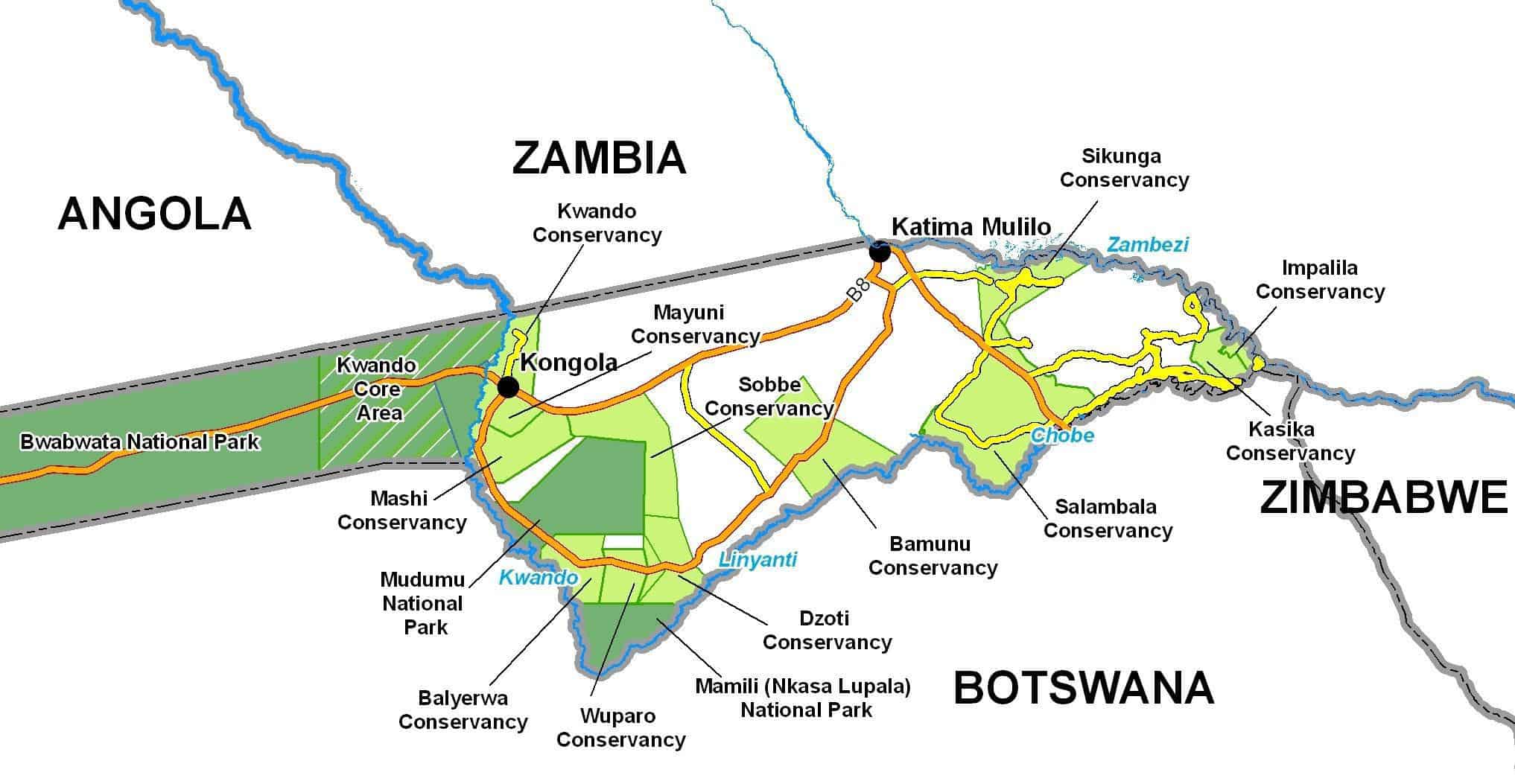With iconic rivers and game-rich floodplains, Namibia’s Zambezi region offers a fresh perspective on the country. You’ll find unforgettable camps in the area’s national parks. By Lea Erasmus
Formerly known as the Caprivi Strip, the Zambezi region stretches from Rundu to Katima Mulilo with a southern point fading into the Linyanti swamp. The landscape is characterised by its rivers: there’s the Kavango in the west, the Kwando towards the center and the Zambezi in the east. We like to call it the Route of Three Rivers and the riverside camps make for unforgettable self-drive destinations. It’s a part of Namibia we came to know well while researching destinations for our company, Ultimate Routes.

The region has been called ‘The poor man’s Delta’ and it’s quite apt. The national parks don’t cost you an arm and a leg just to get in, unlike their counterparts in neighbouring countries. The service is friendly, conservation efforts thriving and the roads generally well maintained. You can get around with a 4×4 or 2×4 in most areas, save some sandy roads in the national parks that require 4×4 and a little grit when it comes to competing for a piece of road with an elephant or ten.

Just like the three iconic rivers, Zambezi also has three must-visit national parks: Bwabwata, Mudumu and Nkasa Rupara . Each park has its own unique feeling, vegetation and special attractions. Each also has spectacular campsites where you can soak up the Zambezi feeling.
Bwabwata National Park
To explore the west of Bwabwata, we picked Ngepi Camp as a base. Riverside campsites look out onto the Buffalo Core Area so you’re bound to do some good game viewing from your camp chair. Quick access to the parks from here, fishing excursions and sunset cruises on the Kavango can fill your days. At night, fall into peaceful slumber with hippos and other night creatures in close quarters. Highlights for us were close-by buffalo herds and watching black herons hunt on the floodplains. Shametu River Lodge does boat or mokoro rides to the Popa Falls and has a lovely deck overlooking the Kavango River for a bite to eat and a cold one. Their campsites have exclusive bathrooms/kitchen huts and cater for large groups also.

Camping in the heart of Bwabwata National Park is a MUST. There’s only one camp and it’s only accessible by 4×4. Nambwa Campsite (or Nambwa Tented Camp for those who prefer a luxurious tree-top stay) is spectacular when it comes to close encounters. During our visit, our campsite was visited by an elephant and her calf. I hauled the laptop into the car and we stood under our awning as branches and leaves came raining down on our campsite. We won’t soon forget the sight of the hefty elephant and the tiny calf between her two gigantic feet.

There are wonderful camps on the eastern side of the Kwando if you don’t get a spot at Nambwa or for additional days experiencing river and bush activities.
Mudumu Game Reserve
This small park packs a big punch for the self-drive traveler! Nakatwa Camps offer three exclusive, riverside sites with no amenities and we were lucky enough to call one home. The vegetation in Mudumu is beautiful and varied, from grassy floodplains and massive tree-topped termite mounds to riverine woodland and mopani forests. Our game drives produced sightings of cheetah, buffalo, zebra, sable antelope and a few new birds like the Arnot’s Chat, Slender-billed Honeyguide and Pygmy Geese at sunset from our wild campsite in the park.

Nkasa Rupara National Park
Camping in the unfenced Rupara Community Rest Camp is a unique experience. There are shady campsites under huge trees on the banks of seasonal river channels of the Linyanti Swamp. Campsite visitors include elephants, resident pool hippos and bustling bird parties. Daily drives into Nkasa Rupara (previously known as Mamili National Park) produced epic plains game sightings including the elusive Puku and Reed Buck. The landscape is reminiscent of the Okavango Delta, with vast grassy plains decorated with tree-islands and interconnecting water channels. Summertime birding here is a festival of special sightings! Livingstone’s Camp as an alternative adds a glamping experience if you want a little more privacy and convenience.

A stop-over at Katima Mulilo serves as a good stocking-up and turn-around point or transit stop. Not only is it a beautiful riverside-camping location with fishing, boat cruises and even houseboats, but it’s also the gateway to Zambia and Botswana.
Bucket-list experiences in Zambezi
- Hippo Pool swimming at Ngepi Camp
- Ngepi Camp’s bathrooms are the funkiest ablutions we ever did see. Poopa Falls, Lav-a-Tree, Bos K@k, The Throne and Fish Eagle Bath (a bath on a deck overlooking the Kavango).

- Horseshoe Bend is the place to go for an elephant gathering like no other.
- Kwando adventures – visit Mashi River Safaris for guided boat rides or walks in the conservancy.
- Wild camp in Mudumu National Park.
- Sunrise on the Linyanti Floodplains – get into the park early for a sunrise coffee & bush brekkie.
- Tiger fishing and houseboats on the Zambezi River
Set off on your overlanding trip with confidence, armed with the Tracks4Africa Namibia Self-Drive Guide. Along with destination descriptions and a full atlas section, you’ll get invaluable information to help you plan and carry out your trip, from handling the red tape at the border to road conditions and vet fences. Get the guide book with the Namibia Traveller’s Paper Map in a bundle and save on both.


http://www.Livingstonescamp.com
Ahhh the Zambezi region is incredible amazing unforgettable! Rupara Community Rest Camp was definitely a highlight as was Malyo Wilderness Camp! I’ll be back in a heartbeat
Zambezi is now a real destination not just a stop over while driving to other areas of KAZA.
Make sure you stay in lodges that are members of The Namibian Wetlands Route association that guarantee the best practices and sustainable tourism approach with the local communities.
http://www.namibiawetland.com